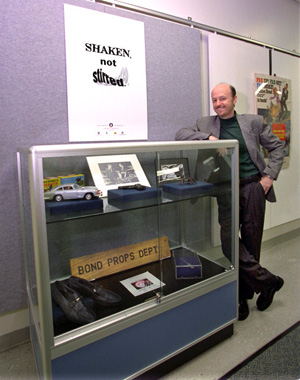 |
|
|
Click on the Spy-Fi Logo to tour the Archives. |
40 Years of TV and Movie Spy Fiction
 |
|
James Bond items from the Spy Fi Exhibit |
James Bond, Maxwell Smart, and Illya Kuryakin were among the spy fiction characters that captured Americans' imaginations in the ‘60’s and let them dream of a life filled with intrigue and adventure.
Among those caught up in the spy fiction craze was Danny Biederman, a Hollywood screenwriter, author, and consultant specializing in movie and TV spy fiction, who realized at an early age that collecting spy show memorabilia was safer than actually being a spy. The Central Intelligence Agency’s Fine Arts Commission hosted the first major exhibition of 400 props, photographs, and works of art from Biederman’s private collection of 4,000 items from August 10, 2000 through January 5, 2001.
The Spy Fi Archives is an entertaining look at how Hollywood viewed intelligence work during the Cold War and beyond. When President John F. Kennedy revealed his fondness for Ian Fleming’s James Bond novels in the early 1960s, the spy fiction craze began in the United States and internationally. While CIA’s intelligence officers were tight-lipped about their sometimes life-and-death Cold War mission, the movie industry eagerly filled the void with glamour, intrigue, and even humor—with some interesting implications for the real world of intelligence.
The Shoe Phone and the Pen Communicator were but fantasy precursors to today’s wireless communications and James West’s sleeve gun device a variation on the Office of Strategic Services’ glove pistol from WW II, fulfilling the spy world’s need for concealment. These are examples of art imitating life. Conversely the Spy Fi exhibit was located near the Cold War Exhibit at the CIA, a private collection of real-life spy memorabilia owned by H. Keith Melton, which contains devices used by real world counterparts: the U.S. Office of Strategic Services, the USSR’s KGB, and the East German’s Stasi.
Like real intelligence officers, TV and movie spies knew the value of protecting their sources and methods—they operated secretly and without the public recognition that the actors who portrayed them received in abundance. They portrayed the adventure, resourcefulness and dedication to a greater cause that inspired some Agency employees in their choice of work. Their world also reflected the diversity in personnel necessary for an effective intelligence gathering organization (e.g., Bill Cosby in “I Spy” and Diana Rigg in “The Avengers”).
Today while the Cold War is over, the Berlin Wall is down, and new maps are drawn, the CIA’s work is far from done. In this new world, the Agency reveals much more about its work to keep Americans safe from cybercrime, weapons proliferation, drug trafficking, and terrorists. But what can be revealed can never compete with the thrillers Hollywood continues to produce to entertain the public and …spies like us.
On behalf of the Central Intelligence Agency and its employees, the CIA Fine Arts Commission thanks Danny Biederman for having made this exhibit possible.
Return to CIA Homepage
| Click on the Spy-Fi Logo to tour the Archives. | |